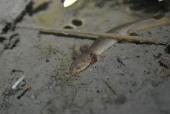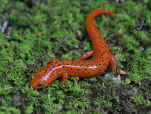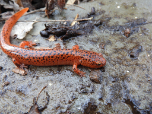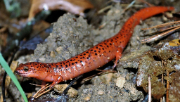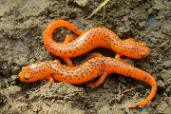Northern Red Salamander (Pseudotriton ruber ruber)
Description: Red salamanders range in length from 4 to 7 inches. These stout-bodied salamanders range from a purple-brown to a bright, crimson red with irregularly shaped, dark spots along their backs. Younger individuals tend to exhibit brighter colors, while adults darken with age. Red salamanders are equipped with a projectile tongue that extends and withdraws in just 11 milliseconds. They also have glands that produce a toxic secretion to deter predators. When threatened—most commonly by birds, skunks and raccoons—these salamanders assume a defensive posture. They curl their bodies into a c-shape, wrapping their tails and hind limbs around to protect their head.
Habitat: These salamanders are aquatic and terrestrial. They prefer cold, clear streams and are also found in wooded areas under rocks, bark and leaf litter.
Range: The red salamander's range extends from parts of northern New York to the Gulf Coast in elevations ranging from sea level to about 1500 feet. They are absent from coastal plains south of Virginia and the Florida peninsula.
Diet: They eat a variety of small invertebrates, including arachnids, worms and small insects. They also occasionally feed on smaller salamanders. Because they depend on damp habitats, their foraging range changes with the seasons, expanding during wet seasons and retracting in dry seasons.
Reproduction: Pseudotriton ruber usually breeds annually, but mating season varies geographically. Courtship involves head rubbing and a tail-straddling walk, typical of plethodontid salamanders. The male then deposits a spermatophore for the female to pick up, to be used later for fertilization. Females may retain sperm for several months before oviposition. Males may deposit up to two spermatophores per night. Some males have been observed courting other males, in what may be an effort to improve their own chances with females by causing a rival male to waste a spermatophore.
Eggs are laid during fall or early winter. The eggs, about 4mm in diameter, are attached in water to the underside of rocks and logs in streams, bogs, or springs. Females brood the eggs for 2 to 3 months until the eggs hatch. Males typically begin breeding 4 to 5 years after metamorphosis, females after 5 or more years. Snout vent length at time of reproduction is 53 to 63 mm in males, 55 to 68 mm in females. Larvae are found in slow moving regions of streams or springs, feeding on aquatic invertebrates among decaying leaves and aquatic plants. The larval stage may last 1.5 to 3.5 years, with longer larval periods corresponding to more northern populations. Transformation occurs in late spring and summer
Status: Listed as Least Concern in view of its wide distribution and presumed large population.
»» Kingdom: Animalia - Animals
»» Phylum: Chordata - Chordates
»» Subphylum: Vertebrata - Vertebrates
»» Class: Amphibia - (Amphibians)
»» Order: Caudata - Salamanders
»» Family: Plethodontidae - Lungless Salamanders
»» Genus: Pseudotriton
»» Species: Pseudotriton ruber - Red Salamander
»» Subspecies: Pseudotriton ruber ruber - Northern Red Salamander
This article uses material from the Wikipedia article "Red Salamander", which is released under the Creative Commons Attribution-Share-Alike License 3.0. Content may have been omitted from the original, but no content has been changed or extended.
|



